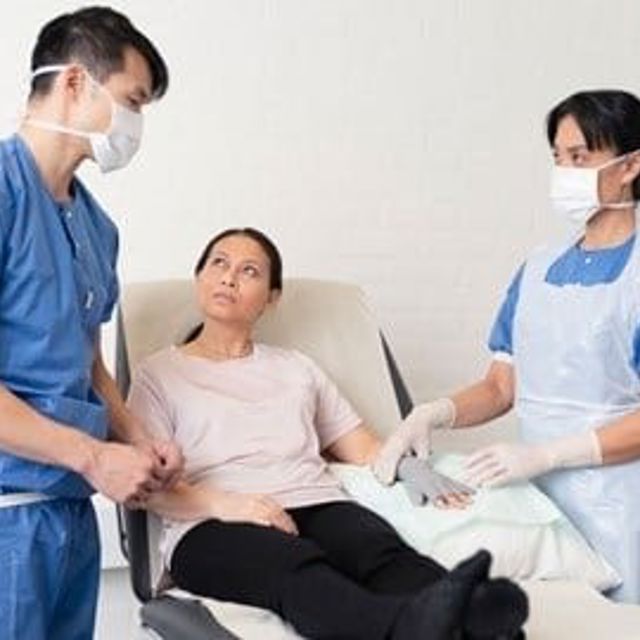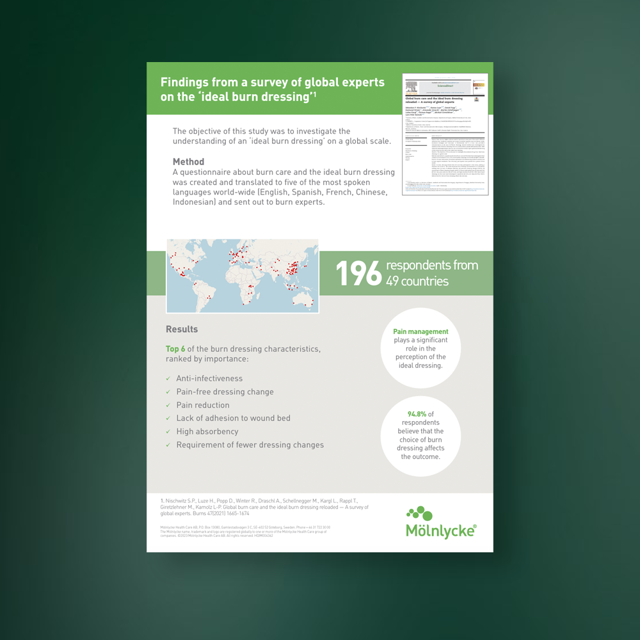Information for health care professionals
Burns are a challenging wound type, associated with a complex burn care continuum.
Burn care across all burn wound healing stages, including burn scar healing, demands a deeper understanding of burn care and research, the long-term effects of burn injuries and the best treatment for burns according to burn type.
At Mölnlycke, we are committed to supporting you in your learning, professional education and daily clinical practice with:
- Educational content: webinars, e-learnings
- Clinical resources: summaries of clinical trials/studies
- Tips & tricks: cutting and application guides
How to choose a dressing for burns
Different burn dressings and dressing protocols address different burn needs:
- For superficial partial-thickness burns, burn dressings should be left on the wound for long periods of time (at least one week), until healing3, 4
- Partial-thickness burns have moderate to high exudate levels where foams and alginates can be an option4
- Antimicrobial dressings for burns, such as silver dressings, may be used prophylactically as a barrier to microorganisms5

Use of silver sulfadiazine (SSD)
A systematic review concluded that standard use of silver sulfadiazine (SSD) in the conservative treatment of partial-thickness burns can no longer be supported6.
Survey of global experts on the “ideal burn dressing”
In 2021, a survey among global experts on the “ideal burn dressing” was published. The objective of this study was to investigate what dressing is most appropriate for a burn on a global scale via a questionnaire. 196 experts from 49 countries participated in the survey7 .
The results of the study show:
- Pain management plays a significant role in the perception of the ideal dressing
- Silver-based dressings are the most used dressings for superficial (45.2%) and
deep burns (52.8%) - 94.8% believe that the choice of burn dressing affects the outcome
The top 6 burn dressing characteristics, ranked by importance:
- Anti-infectiveness
- Pain-free dressing change
- Pain reduction
- Lack of adhesion to wound bed
- High absorbency
- Requirement of fewer dressing changes

Survey of global experts on the ‘ideal burn dressing’
The objective of this study was to investigate the understanding of an ‘ideal burn dressing’ on a global scale.
Learn more about the findings
with Professor Kamolz, co-author of the publication:
Selection of burn dressings: Guidelines
The choice of a dressing for burns should consider several factors. The following are guidelines in burn dressing selection:
- European Burn Association (EBA) guidelines3
The choice of burn dressings depends on cause, size, depth, location, degree of exudation, contamination level and costs.
- International Society for Burns Injuries (ISBI) guidelines4
Characteristics of an ideal dressing would be the following:
- Provides an optimum environment for moist wound healing
- Allows gaseous exchange of oxygen, carbon dioxide and water vapor
- Provides thermal insulation
- Impermeable to microorganisms
- Free from particulate contaminants
- Non-adherent
- Safe to use
- Acceptable to the patient
- High absorption properties
- Cost-effective
- Allows monitoring of the wound
- Provides mechanical protection
- Nonflammable
- Sterile
- Available in all settings
- Requires infrequent changes
- Ready to use to reduce dressing time

Burn care in the Asia Pacific region
A panel of 14 burn experts in the Asia Pacific region has published a consensus report on the assessment and treatment of burn wounds with the aim to improve the clinical outcomes for burn patients in the region.
Mepilex Ag – a proven solution for partial thickness burns
Mepilex Ag is a versatile and soft antimicrobial foam dressing that absorbs exudate and maintains a moist wound environment – specifically developed to treat burns2. The Safetac wound contact layer prevents the dressing from adhering to the wound bed, minimising pain and trauma during removal2–3.
Mepilex Ag has been shown to contribute to reduced nursing time during first dressing application and reduced pain at removal in comparison to other dressing options in a paediatric population2, 4. Compared to silver sulfadiazine, RCT results show that Mepilex® Ag leads to a shortened length of hospital stay, reduced pain during wear and lower total cost of treatment3.
Testimonials
-
Listen to burn surgeon Kevin Foster as he shares his clinical experiences using Mepilex Ag.
-
References
- Evans LH, Bhavsar D, Mailander P (2010) The biology of burn injury. Exp Dermatol 19(9): 777-83
- Warby R, Maani CV (2019) Burn Classification. Available from: https://www.ncbi.nlm.nih.gov/books/NBK539773/
- European Practice Guidelines for Burn Care. 2017
- ISBI Practice Guidelines for Burn Care, Part 1, 2016
- Wounds International. International consensus. Appropriate use of silver dressings in wounds. An expert working group consensus. London, UK: Wounds Int; 2012 [cited 14 Sep 2017]. URL: http://www.woundsinternational.com/media/issues/567/files/content_10381.pdf.
- Heyneman A. et al. The role of silver sulphadiazine in the conservative treatment of partial thickness burn wounds: A systematic review. Burns. 2016 42(7):1377-1386
- Nischwitz SP, Luze H, Popp D, Winter R, Draschl A, Schellnegger M, Kargl L, Rappl T, Giretzlehner M, Kamolz L-P. Global burn care and the ideal burn dressing reloaded — A survey of global experts. Findings from a survey of global experts on the ‘ideal burn dressing’ results. Burns. 2021 47:1665-1674.
Related articles
Read all-

Wound care | 5 min read Rethinking surgical incision care
Undisturbed wound healing (UWH) in post-surgical settings is a key focus for rethinking surgical incision care. UWH is a principle that reduces patient mortality, improves recovery time, increases patients’ quality of life and reduces costs¹.
-

Wound care | 5 min read Cost-effectiveness of burn dressings
Cost-effectiveness is an important factor in implementing a treatment regimen for burns. Burn care is associated with high costs, but it is important to look beyond price-per-unit to consider the total cost of care and cost savings realised by fewer dressing changes, less nursing time required, and fewer pain relief medications.
-

Wound care | 4 min read Burn dressings for children burn patients
Burn injuries are a significant concern in the paediatric population, with children being particularly susceptible due to their natural curiosity and developing motor skills. Scalds are notably prevalent among young children. Specialised care and gentle wound dressings are needed to care for paediatric burn patients.
-

Wound care | 4 min read Making burn treatment less painful
Burn injuries affect millions globally each year and present trauma in the form of physical and psychological challenges during the healing process. The pain and trauma associated with burn treatments, particularly during dressing changes and also for those with sensitive and fragile skin, such as children and the elderly, is a focus of recent advancements in burn care, emphasising the importance of minimising pain to promote effective healing and improve patient outcomes.
-

Wound care | 5 min read Minimising risk of infection in burn care
Burn injuries compromise the skin's integrity, exposing patients to a heightened risk of infection, which can impede healing and increase morbidity and mortality. Implementing effective measures for minimising risk of infection, such as dressing selection, antimicrobial dressings, and a new approach to dressing-change protocols, is critical.
-

Wound care | 3 min read Characteristics of an ideal burn dressing
Burn wounds are complex and require specialist, multidisciplinary, and comprehensive care. To secure the best chances of healing, it’s important to consider burn dressing choice. The ideal burn dressing combines concern for supporting undisturbed healing, fostering a positive patient experience and comfort, and positive clinical outcomes with the need to avoid complications that can lead to increased morbidity and mortality.
-
Wound care | 2 min read Tips and tricks to prevent pressure injuries in the OR: criteria for assessing patient risk
Watch video -
Wound care | 3 min read Tips and tricks to prevent pressure injuries in the OR: practical steps for nurses and nurse managers
Watch video -

Wound care | 2 min read Venous Leg Ulcers and the never ending problem of leakage
Living with the distressing consequences of leakage from a venous leg ulcer (VLU) can undoubtedly significantly diminish a patient's quality of life. Individuals enduring the challenges of highly exuding wounds, such as VLUs, deserve a higher quality of healthcare. The disruptive effects of exudate leakage on daily life should no longer be tolerated. Change is coming…